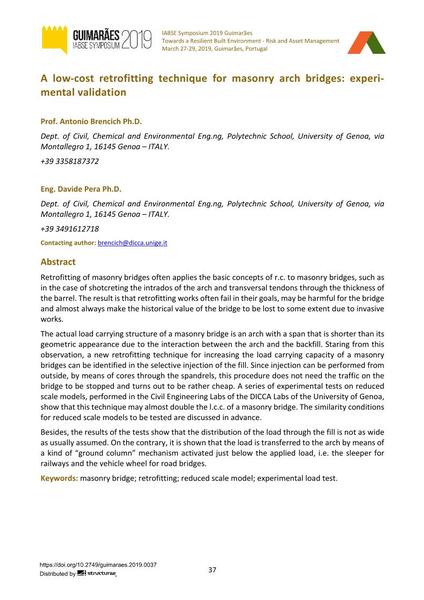A low-cost retrofitting technique for masonry arch bridges: experi- mental validation

|
|
|||||||||||
Bibliographic Details
| Author(s): |
Antonio Brencich
(Dept. of Civil, Chemical and Environmental Eng.ng, Polytechnic School, University of Genoa, via Montallegro 1, 16145 Genoa – ITALY.)
Davide Pera (Dept. of Civil, Chemical and Environmental Eng.ng, Polytechnic School, University of Genoa, via Montallegro 1, 16145 Genoa – ITALY.) |
||||
|---|---|---|---|---|---|
| Medium: | conference paper | ||||
| Language(s): | English | ||||
| Conference: | IABSE Symposium: Towards a Resilient Built Environment Risk and Asset Management, Guimarães, Portugal, 27-29 March 2019 | ||||
| Published in: | IABSE Symposium Guimarães 2019 | ||||
|
|||||
| Page(s): | 37-45 | ||||
| Total no. of pages: | 9 | ||||
| DOI: | 10.2749/guimaraes.2019.0037 | ||||
| Abstract: |
Retrofitting of masonry bridges often applies the basic concepts of r.c. to masonry bridges, such as in the case of shotcreting the intrados of the arch and transversal tendons through the thickness of the barrel. The result is that retrofitting works often fail in their goals, may be harmful for the bridge and almost always make the historical value of the bridge to be lost to some extent due to invasive works. The actual load carrying structure of a masonry bridge is an arch with a span that is shorter than its geometric appearance due to the interaction between the arch and the backfill. Staring from this observation, a new retrofitting technique for increasing the load carrying capacity of a masonry bridges can be identified in the selective injection of the fill. Since injection can be performed from outside, by means of cores through the spandrels, this procedure does not need the traffic on the bridge to be stopped and turns out to be rather cheap. A series of experimental tests on reduced scale models, performed in the Civil Engineering Labs of the DICCA Labs of the University of Genoa, show that this technique may almost double the l.c.c. of a masonry bridge. The similarity conditions for reduced scale models to be tested are discussed in advance. Besides, the results of the tests show that the distribution of the load through the fill is not as wide as usually assumed. On the contrary, it is shown that the load is transferred to the arch by means of a kind of “ground column” mechanism activated just below the applied load, i.e. the sleeper for railways and the vehicle wheel for road bridges. |
||||
| Keywords: |
retrofitting masonry bridge reduced scale model experimental load test
|
||||
